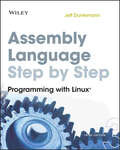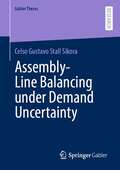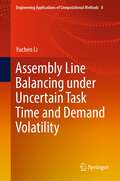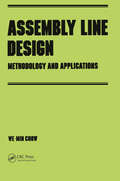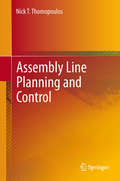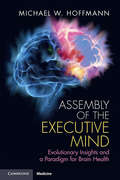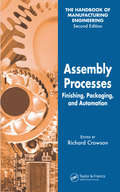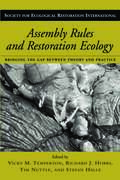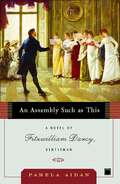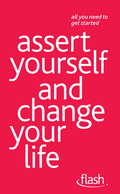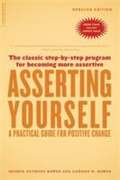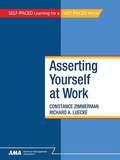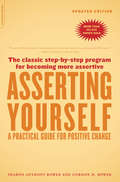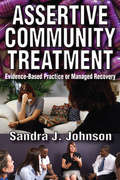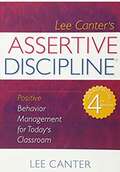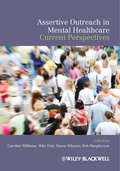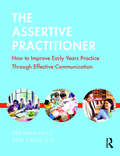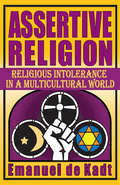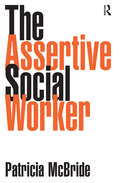- Table View
- List View
Assembly Language Step-by-Step
by Jeff DuntemannThe eagerly anticipated new edition of the bestselling introduction to x86 assembly languageThe long-awaited third edition of this bestselling introduction to assembly language has been completely rewritten to focus on 32-bit protected-mode Linux and the free NASM assembler. Assembly is the fundamental language bridging human ideas and the pure silicon hearts of computers, and popular author Jeff Dunteman retains his distinctive lighthearted style as he presents a step-by-step approach to this difficult technical discipline.He starts at the very beginning, explaining the basic ideas of programmable computing, the binary and hexadecimal number systems, the Intel x86 computer architecture, and the process of software development under Linux. From that foundation he systematically treats the x86 instruction set, memory addressing, procedures, macros, and interface to the C-language code libraries upon which Linux itself is built.Serves as an ideal introduction to x86 computing concepts, as demonstrated by the only language directly understood by the CPU itselfUses an approachable, conversational style that assumes no prior experience in programming of any kindPresents x86 architecture and assembly concepts through a cumulative tutorial approach that is ideal for self-paced instructionFocuses entirely on free, open-source software, including Ubuntu Linux, the NASM assembler, the Kate editor, and the Gdb/Insight debuggerIncludes an x86 instruction set reference for the most common machine instructions, specifically tailored for use by programming beginnersWoven into the presentation are plenty of assembly code examples, plus practical tips on software design, coding, testing, and debugging, all using free, open-source software that may be downloaded without charge from the Internet.
Assembly-Line Balancing under Demand Uncertainty (Gabler Theses)
by Celso Gustavo Stall SikoraAssembly lines are productive systems, which are very efficient for homogeneous products. In the automotive industry, an assembly line is used in the production of several vehicle variants, including numerous configurations, options, and add-ins. As a result, assembly lines must be at the same time specialized to provide high efficiency, but also flexible to allow the mass customization of the vehicles. In this book, the planning of assembly lines for uncertain demand is tackled and optimization algorithms are offered for the balancing of such lines. Building an assembly line is a commitment of several months or even years, it is understandable that the demand will fluctuate during the lifetime of an assembly line. New products are developed, others are removed from the market, and the decision of the final customer plays a role on the immediate demand. Therefore, the variation and uncertainty of the demand must be accounted for in an assembly line. In this book, methods dealing with random demand or random production sequence are presented, so that the practitioners can plan more robust and efficient production systems.
Assembly Line Balancing under Uncertain Task Time and Demand Volatility (Engineering Applications of Computational Methods #8)
by Yuchen LiThis book introduces several mathematical models in assembly line balancing based on stochastic programming and develops exact and heuristic methods to solve them. An assembly line system is a manufacturing process in which parts are added in sequence from workstation to workstation until the final assembly is produced. In an assembly line balancing problem, tasks belonging to different product models are allocated to workstations according to their processing times and precedence relationships among tasks. It incorporates two features, uncertain task times, and demand volatility, separately and simultaneously, into the conventional assembly line balancing model. A real-life case study related to the mask production during the COVID-19 pandemic is presented to illustrate the application of the proposed framework and methodology. The book is intended for graduate students who are interested in combinatorial optimizations in manufacturing with uncertain input.
Assembly Line Design: Methodology and Applications
by We-Min ChowThis book attempts to treat line design and its related subjects in a cohesive manner, with an emphasis on design applications. It discusses general guidelines for setting up assumptions and determining line performance parameters, based on empirical data from literature reports.
Assembly Line Planning and Control
by Nick T. ThomopoulosAssembly Line Planning and Control describes the basic fundamentals of assembly lines for single model lines, mixed model make-to-stock lines, mixed model make-to-order lines and for one-station assembly. The book shows how to select the quantity of units to schedule for a shift duration, compute the number of operators needed on a line, set the conveyor speed, coordinate the main line with sub-assembly lines, assign the work elements to the operators on the line, sequence the models down the line, sequence the jobs down the line, calculate the part and component requirements for a line and for each station, determine the replenish needs of the parts and components from the suppliers, compute the similarity between the models being produced and show applications, use learning curves to estimate time and costs of assembly, and measure the efficiency of the line. The material is timeless and the book will never become obsolete. The author presents solutions with easy-to-understand numerical examples that can be applied to real-life applications.
Assembly of the Executive Mind: Evolutionary Insights and a Paradigm for Brain Health
by Michael W. HoffmannOver 90% of the brain is concerned with higher cortical functions, yet understanding of syndromes, functions, and measurements remains unchartered. This valuable handbook illuminates brain function, natural environment and human function, by delving into the interdisciplinary study. Multifaceted in its perspective, this book demonstrates bi-directionality of information exchange between disciplines. This book weaves around key case reports, series, control studies and cohort studies from cognitive neurology registries, to present the most current, practical research. Gaining appreciation for the fundamental formation and assembly of the supervisory area of the brain will inform an understanding of conditions and behavior for neuroscience professionals, clinical brain scientists and medical students in neuroscience, worldwide. Authored by a leading expert in cognitive neurology, this book guides the reader through the evolutionary, or neuro-archeological, aspects of how the frontal lobes and their circuitry were assembled, drawing key insights into form, function and treatment.
Assembly Processes: Finishing, Packaging, and Automation (Handbook of Manufacturing Engineering, Second Edition)
by Richard CrowsonToday's fast-paced manufacturing culture demands a handbook that provides how-to, no-holds-barred, no-frills information. Completely revised and updated, the Handbook of Manufacturing Engineering is now presented in four volumes. Keeping the same general format as the first edition, this second edition not only provides more information but makes i
Assembly Rules and Restoration Ecology: Bridging the Gap Between Theory and Practice (Science Practice Ecological Restoration #5)
by Richard J. Hobbs Vicky M. Temperton Tim Nuttle Stefan HalleUnderstanding how ecosystems are assembled -- how the species that make up a particular biological community arrive in an area, survive, and interact with other species -- is key to successfully restoring degraded ecosystems. Yet little attention has been paid to the idea of assembly rules in ecological restoration, in both the scientific literature and in on-the-ground restoration efforts. Assembly Rules and Restoration Ecology, edited by Vicky M. Temperton, Richard J. Hobbs, Tim Nuttle, and Stefan Halle, addresses that shortcoming, offering an introduction, overview, and synthesis of the potential role of assembly rules theory in restoration ecology. It brings together information and ideas relating to ecosystem assembly in a restoration context, and includes material from a wide geographic range and a variety of perspectives. Assembly Rules and Restoration Ecology contributes new knowledge and ideas to the subjects of assembly rules and restoration ecology and represents an important summary of the current status of an emerging field. It combines theoretical and practical aspects of restoration, making it a vital compendium of information and ideas for restoration ecologists, professionals, and practitioners.
An Assembly Such as This: A Novel of Fitzwilliam Darcy, Gentleman
by Pamela AidanThe first installment in Pamela Aidan&’s irresistible trilogy, An Assembly Such As This takes us into the world of Jane Austen&’s Fitzwilliam Darcy.&“She is tolerable; but not handsome enough to tempt me.&” So begins the timeless romance of Fitzwilliam Darcy and Elizabeth Bennet in Pride and Prejudice. Jane Austen's classic novel is beloved by millions, but little is revealed in the book about the mysterious and handsome hero, Mr. Darcy. And so the question has long remained: Who is Fitzwilliam Darcy? In An Assembly Such as This, Pamela Aidan finally answers that long-standing question. In this first book of her Fitzwilliam Darcy, Gentleman trilogy, she reintroduces us to Darcy during his visit to Hertfordshire with his friend Charles Bingley and reveals Darcy's hidden perspective on the events of Pride and Prejudice. As Darcy spends more time at Netherfield supervising Bingley and fending off Miss Bingley's persistent advances, his unwilling attraction to Elizabeth grows—as does his concern about her relationship with his nemesis, George Wickham. Setting the story vividly against the colorful historical and political background of the Regency, Aidan writes in a style comfortably at home with Austen but with a wit and humor very much her own. Aidan adds her own cast of fascinating characters to those in Austen's original, weaving a rich tapestry from Darcy's past and present. Austen fans and newcomers alike will love this new chapter of the most famous romance of all time.
Asser's Life of King Alfred
by AsserAlfred the Great (848 - 899) was a king in West Saxon and then the first king of the Anglo-Saxons, king of Britain. He spent his early career fighting Viking invasions, until in 878 he won a decisive victory against them, and then personally oversaw the conversion of the Viking leader to Christianity. He left a legacy for being gracious, rational, peaceable, and generally working to improve the overall quality of people's lives. This biography was composed by Asser (d. 909), a Welsh monk and later bishop.-Print ed.
Asser's Life of King Alfred, Together with the Annals of Saint Neots
by William Henry StevensonAsser (died c. 909) was a Welsh monk from St David's, Dyfed, who became Bishop of Sherborne in the 890s. About 885 he was asked by Alfred the Great to leave St David's and join the circle of learned men whom Alfred was recruiting for his court. After spending a year at Caerwent because of illness, Asser accepted.In 893 Asser wrote a biography of Alfred, called the Life of King Alfred. The manuscript survived to modern times in only one copy, which was part of the Cotton library. That copy was destroyed in a fire in 1731, but transcriptions that had been made earlier, together with material from Asser's work which was included by other early writers, have enabled the work to be reconstructed. The biography is the main source of information about Alfred's life and provides far more information about Alfred than is known about any other early English ruler. Asser assisted Alfred in his translation of Gregory the Great's Pastoral Care, and possibly with other works.
Assert Yourself: Bullet Guides
by Amanda Vickers Steve BavisterAssert Yourself [Bullet Guide] will give you the help you need. Now. This handy little book covers the key things you need to know, and do, to become more assertive. It's laid out in bullet points so you can find the help you need at a glance. It covers all the major areas, from learning how to say no to using body language to give off assertive signals. This is the fastest, most effective way to be more assertive you'll ever find. Problem solved.
Assert Yourself and Change Your Life: Flash
by Suzie HaymanDo you want to be more assertive but don't know where to start? Get a kickstart with this little book which will give you just enough to get you going...
Assert Yourself and Change Your Life: Flash
by Suzie HaymanDo you want to be more assertive but don't know where to start? Get a kickstart with this little book which will give you just enough to get you going...
Assert Yourself: Bullet Guides
by Steve Bavister Amanda VickersAssert Yourself [Bullet Guide] will give you the help you need. Now. This handy little book covers the key things you need to know, and do, to become more assertive. It's laid out in bullet points so you can find the help you need at a glance. It covers all the major areas, from learning how to say no to using body language to give off assertive signals. This is the fastest, most effective way to be more assertive you'll ever find. Problem solved.
Asserting Native Resilience: Pacific Rim Indigenous Nations Face the Climate Crisis
by Zoltán Grossman Alan ParkerIndigenous nations are on the front line of the climate crisis. With cultures and economies among the most vulnerable to climate-related catastrophes, Native peoples are developing twenty-first century responses to climate change that serve as a model for Natives and non-Native communities alike. Native American tribes in the Pacific Northwest and Indigenous peoples around the Pacific Rim have already been deeply affected by droughts, flooding, reduced glaciers and snowmelts, seasonal shifts in winds and storms, and the northward movement of species on the land and in the ocean. Using tools of resilience, Native peoples are creating defenses to strengthen their communities, mitigate losses, and adapt where possible. Asserting Native Resilience presents a rich variety of perspectives on Indigenous responses to the climate crisis, reflecting the voices of more than twenty contributors, including tribal leaders, scientists, scholars, and activists from the Pacific Northwest, British Columbia, Alaska, and Aotearoa / New Zealand, and beyond. Also included is a resource directory of Indigenous governments, NGOs, and communities and a community organizing booklet for use by Northwest tribes.
Asserting Yourself: A Practical Guide for Positive Change (Updated Edition)
by Sharon Anthony Bower Gordon H. BowerUtilizing a number of techniques from behavior-change psychology, speech, communications, and acting, the authors Sharon and Gordon Bower outline an effective assertiveness program to help people improve their self-esteem, articulate their opinions, and develop meaningful relationships.
Asserting Yourself at Work
by Constance Zimmerman Richard LueckeTechniques for managing others while maintaining mutual respect. Asserting Yourself at Workprovides business professionals with the communication tools and psychological foundation they need to perform more assertively on the job. Designed for front-line managers, supervisors, team leaders, team members, employees, and life-long learners, this course promotes the use of direct, inclusive communication as a powerful tool for achieving targeted goals and building lasting relationships. Asserting Yourself at Workteaches students the skills they need to behave and communicate more assertively—and therefore more effectively—in the workplace. Students learn to address their needs and interests at work, and, at the same time, consider the needs and interests of others. Beginning with the foundation of self-awareness, the course builds these skills step by step. Students learn about and practice assertive verbal and nonverbal communication techniques, learn how to set proper boundaries in workplace relationships, and analyze how assertiveness plays out in other cultures. The interactive format includes self-assessment tools, worksheets, sidebars, exercises, and quizzes that prompt students all along the way. Course Objective: Understand techniques for managing others while maintaining mutual respect and recognize and avoid self-defeating behaviors. Selected Learning Objectives • Set boundaries • Manage others without being aggressive or manipulative • Respond to other people's needs without giving up your own • Say "no" to unfair demands • Resolve conflicts and deal with aggressiveness in others • Enhance your self-image—and your on-the-job authority
Asserting Yourself-Updated Edition: A Practical Guide For Positive Change
by Sharon Anthony Bower Gordon H. BowerThe classic best-selling step-by-step program for becoming more assertive. Utilizing a number of techniques from behavior-change psychology, speech, communications, and acting, the authors Sharon and Gordon Bower outline an effective assertiveness program to help people improve their self-esteem, articulate their opinions, and develop meaningful relationships. Exercises and examples throughout--including the celebrated DESC scripts (describe, express, specify, consequences)--allow readers to practice the program, adapt it to their own lives, and evaluate their progress. For both personal and professional use, Asserting Yourself is the classic guide to building confidence and taking a stand.
Assertive Community Treatment: Evidence-based Practice or Managed Recovery
by Sandra JohnsonThe twenty-first century has witnessed an explosion in studies on comparative health studies, but mental health remains virtually ignored. Unlike the well researched topic of health policy, there is a gap in the marketplace covering mental health policy and health care policymaking. This book fills that gap; it is a comparative analysis of the implementation of Assertive Community Treatment (ACT), an evidence-based practice employed in two states that promises to empower the well-being of individuals suffering from mental illness.Assertive Community Treatment specifically examines the tension separating the notion of client recovery and evidence-based programs. Johnson challenges the assumption that practitioners should rely on evidence-based practices to close the gap between scientific knowledge and practice. She argues that in an era of managed care, this encourages state mental health administrators to adopt policies that are overly focused on outcomes. Programs that can measure the outcomes of care provided, and evidence-based practices, have become central aspects of the quality care agenda.This study traces the role of policy entrepreneurs throughout the Assertive Community Treatment policymaking process. By differentiating mental health in general, qualitative research increases the chances of observing similarities and differences in outcomes. Johnson explains why the ACT model was adopted and implemented. She concludes that there is a clear monopoly by medical researchers and scientists within Assertive Community Treatment research, and as a result, too much emphasis is placed on the roles of policy entrepreneurs as the main innovators in the agenda and policy formulation stages. Johnson presents a strong argument for more innovation in the implementation stage.
Assertive Discipline: Positive Behavior Management for Today's Classroom
by Lee CanterThis book contains the best concepts and teacher-tested strategies by the author plus new content. A special emphasis on the needs of new and struggling teachers includes practical actions for earning student respect and teaching them behavior management skills. <[p><P>The author also introduces a real-time coaching model and explains how to establish a school wide Assertive Discipline program.
Assertive Outreach in Mental Healthcare: Current Perspectives
by Caroline Williams Mike Firn Simon Wharne Rob MacphersonAssertive Outreach in Mental Healthcare: Current Perspectives explores experiences, successes, interventions, and service user stories as well as lessons learned from the implementation experience surrounding assertive intervention. It provides a synthesis of expert experience in the field as well as experiences of grass roots team practitioners.This book makes a valuable contribution to the field by addressing in depth a wide range of topics critical to the delivery of assertive outreach services and providing practitioners with a manual into which they can feed lessons learned from other teams for continuous service improvement. This book is an essential reference for anyone with an interest in assertive outreach and community treatment approaches in mental health. Special features: Provides a contemporary analysis of current service developments in the area Written by experts in the field Covers cross-cutting issues relevant to all areas of community mental health care Includes multiple perspectives: service user, researcher, service manager, commissioner, clinician and carer Covers both service delivery and therapeutic interventions Explores how the assertive outreach model is applied in the UK and Europe
The Assertive Practitioner: How to improve early years practice through effective communication
by Deborah Price Cathy OtaHow a staff team works together and how effective and cohesive they are impacts significantly on the children that they care for as well as having implications for the general early years practice and the success of the business of the setting. Drawing together theory and practice, this book provides comprehensive guidance on assertive communication and offers a range of clear, practical strategies that are easy to implement in the early years setting. The Assertive Practitioner aims to distinguish between assertive, passive, aggressive and passive aggressive communication so that early years practitioners can gain confidence, become more self-aware, reflect on their own practice and develop their effective communication skills. Divided into three parts: ‘what is assertiveness’, ‘using it’ and ‘developing it’, the authors consider the skills of good communication and assertiveness in the early years setting, offering practical guidance on: Recruitment, induction, ongoing staff training and supervision; Disciplinary processes including handling difficult conversations and refocusing a team after a critical incident; Staff relationships with parents and other professionals; Involving the team in problem solving and implementing change; Engaging with the community; How to get support for yourself as a manager. Packed full of practical strategies and case studies, this timely new book will be invaluable support for all those wanting to enhance and improve professional practice and relationships in the early years setting.
Assertive Religion: Religious Intolerance in a Multicultural World
by Emanuel de KadtQuestions about religions and religious institutions have changed dramatically since they first arose many years ago. In the beginning of the twenty-first century, the link of religion with extreme ideologies captures our attention. Such questions have been the focus of a steadily growing number of books. What does Assertive Religion add to the debate?Emanuel de Kadt discusses the relationship of religion to wider social issues such as human rights and multiculturalism. He traces the growth, during the religious revival over the past decades, of assertive, and even coercive, forms of religion, notably—but not exclusively—fundamentalist varieties. He deals with these questions as they relate to the three major Abrahamic religions, thereby addressing a readership wider than that made up of persons interested exclusively in Judaism, Christianity, or Islam.The author takes on issues such as the effects of the "Jewishness" of Israel on the rights of Palestinians; the consequences of the centralized authority structure of the Roman Catholic Church; and the implications of the failure of reform-oriented Muslims to make their voices heard in an organized Islamic reform movement. He is even-handed, focusing on both positive and negative features of each religious perspective, though he does have a clear viewpoint. Assertive Religion adds to increasingly sharp political discussions on issues arising out of religion. It is a must read for anyone interested in how religion is shaping the world of tomorrow.
The Assertive Social Worker
by Patricia McBrideWould you like to feel more in control of yourself and your work? To cope comfortably with any demands the day throws at you? Deal easily with situations without guilt or worry? If so, this is the book for you! Social work is a stimulating and exciting career - but it can also be frustrating and exhausting. It’s easy to get so caught up in the challenges of work that it becomes difficult to see the wood from the trees. If only you were able to step back. The Assertive Social Worker will provide you with the tools to do just that and, as a result, will empower you to do your job better. By treating assertiveness as a set of skills which can be learned, practised and refined, the author opens the door to a way of thinking and behaving which can turn your whole life around. Although assertiveness may not traditionally have been associated with social work or the broader range of caring professions, it is based upon respect for yourself and others - a clear parallel with the underlying principles of your chosen career.
